Читать книгу Sustainable Futures - Raphael Kaplinsky - Страница 2
Table of Contents
Оглавление1 Cover
2 Praise
6 Figures
7 Tables
8 Preface
11 2 The Rise and Fall of the Mass Production Economy 2.1 The Rise and Fall of Economic Growth, 1950–2018 2.2 What Accounts for the Fall in the Rate of Economic Growth? Was it a consequence of a shortage of labour? What about the contribution of investment to the growth slowdown? And what about the productivity of investment? 2.3 Neo-liberalism and the Decline in Growth, Investment and Productivity Free trade and the retreat from Industrial Policy – increasing imbalances between countries The crisis in macroeconomic policy – matching demand with supply Sustaining demand through Quantitative Easing Growing financialization fuelled short-termism and dulled innovation 2.4 Can the Mass Production Paradigm Be Reinvigorated? The Great Recession of 2007–2018 – the sticking plaster wears off Debt continues to spiral Volatility and fragility in the financial sector threaten the likelihood of a new stock market crash Disruption to global supply chains 2.5 So What Does the Future Hold? Notes
12 3 The Bumpy Ride to Social Decay 3.1 The Rise and Rise of Inequality Changing patterns in the distribution of wealth Changing patterns in the distribution of income 3.2 The Startling Growth of ‘Absolute Poverty’ 3.3 Growing Inequality and Poverty Undermine Welfare and Social Solidarity 3.4 Neo-liberal Austerity Policies and the Power of the Plutocracy Caused Growing Inequality and Absolute Poverty The contribution of neo-liberal austerity policies to rising inequality and poverty The plutocracy promoted and legitimized austerity policies 3.5 The Fear of Migration Has Been Used to Fuel Populism 3.6 The Erosion of Liberal Democracy and the Rise of Populism Disrupt the Potential for Sustainable Growth Notes
13 4 The Collapse of Environmental Sustainability 4.1 From the Dawn of Settled Agriculture to the Great Acceleration 4.2 The Transition to the Anthropocene – Take, Make, Use and Waste ‘Taking’ from the biosphere: the example of the energy vector ‘Making’ with what is ‘Taken’ – are we using the earth’s resources more efficiently? Consumption: ‘Using’ what is ‘Made’ ‘Waste’, in and after ‘Use’ 4.3 It All Adds Up to a Crisis in Environmental Sustainability Notes
14 5 Mass Production Runs Out of Steam 5.1 Learning from History – Successive Techno-Economic Paradigms since the Industrial Revolution Growth surges and techno-economic paradigms Learning from history 5.2 The Development, Deployment and Atrophy of the Mass Production Paradigm The ‘Big Bang’ in Mass Production was followed by speculative frenzy, a financial crisis and the Great Depression The deployment of Mass Production and the post-war Golden Age Maturity deferred: the globalization of Mass Production Complementary policy changes in low- and middle-income countries 5.3 Economic and Social Sustainability during the Mass Production Paradigm The synergistic close fit between economic and social sustainability in the Golden Age The erosion of synergy between economic and social sustainability after the Golden Age 5.4 The Crisis in Environmental Sustainability during the Mass Production Paradigm 5.5 Mass Production: The Balance Sheet Notes
15 6 Information and Communication Technologies: The Motor of the New Techno-Economic Paradigm 6.1 The Emergence of the New Heartland Technology 6.2 Digital Logic – the Brains of the System 6.3 The Evolution of ICTs Data storage and communication Computer-integrated and flexible production systems The Internet of Things Big Data and Artificial Intelligence 6.4 Beyond Mass Production ICTs provide the capacity to revive productivity growth ICTs provide the capacity for decentralized production, and thus for bringing residence, production and consumption closer together ICTs can provide the capacity to customize products to meet individual needs ICTs can provide the capacity for shared, rather than individualized, consumption, and for repairable rather than throwaway products ICTs can enhance the capacity for greener production systems, and for the development of renewable energy ICTs provide for peer-to-peer communication that enhances civil society 6.5 Not Just Roses, Also Weeds in the Garden Notes
16 7 Transformative Change in Practice 7.1 Mobile Telephones Transform the Financial Sector and Facilitate Economic and Social Inclusion Mobile phones have promoted financial inclusion and renewable energy in Kenya Social inclusion through access to renewable energy Mobile telephony and techno-economic paradigms 7.2 Renewable Energy, Large Dams and Hydroelectric Power The impact of large hydro in the Zambesi River basin Large dams also support irrigation Is there an alternative to large-dam hydroelectricity? Large hydro, renewables and techno-economic paradigms 7.3 Precision Farming and Robots in Agriculture The extension of mass production in mechanized farming ICTs, robotics and machine-learning can transform mechanized farming Precision farming and techno-economic paradigms 7.4 Three Case-Studies – The Balance Sheet Notes
17 8 What’s To Be Done? 8.1 The What – Visioning a More Sustainable Future A more sustainable environment A more sustainable economy A more sustainable society 8.2 The How – What Actions Will Deliver a More Sustainable World? Regulating and changing behaviour in the financial sector Reducing the concentration of individual and corporate power A Smart Green New Deal Incentivizing changes in behaviour Infrastructure to support the Circular Economy Innovation to support the Green New Deal Strengthening global and local governance Promoting global development 8.3 The Elephant in the Room – Who Will Drive the Transition to a Sustainable World? Notes
18 9 Who Will Do It? Making Change Happen 9.1 Entrepreneurship: Turning Fantasy into Fact 9.2 The Private Sector Provides the Motive Power, the State is at the Steering Wheel (and Sometimes Pays for the Petrol) Beyond the private sector 9.3 Building Coalitions for Change 9.4 Change Is Cumulative 9.5 How to Jump Over Walls Synergistic interventions Governments must act decisively and with vision Confronting reactionary power bases 9.6 Sequencing and Priorities: The Two-Shot Stimulus to a Paradigm Change and the Rebuilding of a Sustainable World The trigger for change Notes
19 Index
